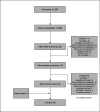Impact of population tobacco control interventions on socioeconomic inequalities in smoking: a systematic review and appraisal of future research directions
- PMID: 32994297
- PMCID: PMC8666809
- DOI: 10.1136/tobaccocontrol-2020-055874
Impact of population tobacco control interventions on socioeconomic inequalities in smoking: a systematic review and appraisal of future research directions
Abstract
Background: While price increases and targeted cessation support have been found to reduce inequalities in smoking by socioeconomic status (SES), evidence on other measures is mixed. We aimed to update the most recent (2014) previous review by identifying and appraising evidence published since 2013 on the equity impact of population tobacco control measures.
Methods: Systematic searching of 10 electronic databases and hand-searching of four key journals identified 68 primary research articles published since 2013 that sought to examine the equity impact of population tobacco control measures in high-income countries with a negative socioeconomic gradient in smoking. Reported equity impacts were categorised as positive (greater impact among lower SES), neutral (no difference by SES), negative (greater impact among higher SES) or mixed/unclear.
Results: There was substantial growth in research seeking to evaluate the equity impact of tobacco control interventions, but the majority of new studies showed mixed/unclear results. Findings for price increases and targeted cessation support continue to suggest an equity-positive impact, but limitations in the available evidence make further assessment difficult. Substantial differences in the context, scale and implementation of tobacco control policies make straightforward comparison of findings from the previous 2014 and current reviews problematic.
Conclusion: Researchers need to adopt more sophisticated, multidisciplinary approaches in evaluating the equity impact of tobacco control measures-developing robust measures of equity effect and using frameworks that take account of context, existing systems/processes and the likely mechanisms of action. Socioeconomic differences in intervention impact within low-income and middle-income countries require evaluation.
Keywords: disparities; public policy; socioeconomic status.
© Author(s) (or their employer(s)) 2020. Re-use permitted under CC BY. Published by BMJ.
Conflict of interest statement
Competing interests: None declared.
Figures
References
-
- World Bank . Tobacco control at a glance. Washington, DC: World Bank, 2003.
-
- WHO . WHO Framework Convention on Tobacco Control. Geneva: World Health Organization, 2003.
-
- WHO . WHO report on the global tobacco epidemic 2017: monitoring tobacco use and prevention policies. Geneva: World Health Organization, 2003.
Publication types
LinkOut - more resources
Full Text Sources


